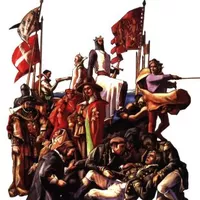CHAPTER CV. VICTORIA—THE LAND OF SNOW
IN days long, long ago, men knew very little of the world, and all the countries it contained. But in the time of Henry VII., great sailors began to sail into far seas and discover new lands. From that time onward there have been many great and daring sailors who have sailed the seas and discovered more and more lands, until the blue of our maps has became marked with islands and continents.
The way to India and China is long, and, in the days when there were no steamers, it was dangerous too. In the time of King Henry VII. a man called Sebastian Cabot tried to find a short way to India, by going round the north of America through the Arctic Ocean. This began the quest of what was called the 'North-West Passage.' For hundreds of years men struggled to find this North-West Passage, but all in vain, and many brave lives were lost in the bitter frost and snow of the far north. As new lands were discovered, the map of the Arctic region began to be filled in bit by bit, but the North-West Passage remained undiscovered.
At last the British Government decided in 1845 A.D. to send out an Arctic expedition, and Sir John Franklin, who had already been on two voyages of discovery to Arctic regions, was put in command.
Sir John was no longer a young man, but he loved the sea and the north, and he went out like an old sea-lion, eager to find the long-sought passage.
He sailed away with two ships, called the Terror and the Erebus, manned by a hundred men and more. The last good-bye was said, the last handshake given, and away sped the ships further and further north into the white and silent land, never again to return.
A year passed, then another. At home anxious hearts waited and waited for news, but no news came. Then, as nothing was heard of the ships and their gallant crews, both Sir John Franklin's wife and the British Government sent out expeditions to try to find the Terror and the Erebus. These new ships sailed to the north, keeping as much as possible in the course Sir John had gone, but they could find no trace of him. Here and there sailors landed on the bare, white shores which they passed, and left supplies of food under great heaps of stones or cairns as they are called. They also left letters telling which way their ships had gone. This they did hoping that some of Franklin's men might pass that way and find the food and letters. The sailors also caught white foxes which run about wild in these cold countries. Round the necks of these foxes they put copper collars on which were engraved directions how to find the ships and the stores of food. The foxes were then let loose again, in the hope that some of them might find their way to the Terror and the Erebus and bring comfort and encouragement to Sir John and his men.
But nothing was of any use. No sign of Franklin and his brave men could be found, although expedition after expedition was sent out. At one time as many as fifteen ships were looking for Franklin, but each one failed.
At last, after about twelve years, the searchers were rewarded. They found a cairn in which was a tin can containing a paper which had been put there by one of Sir John's men. This paper told how at last the North-West Passage had been discovered; how Sir John had died a few days later, and how as the ships were stuck fast in the ice and could not get through to the sea beyond, the men had at last left them and started southward on sledges. That was all.
None of the men ever reached home again. They all died of cold and hunger, and here and there along the way they had gone their skeletons were found bleached and white.
The people who live in the cold, far north are called Eskimos. When they were questioned, some of them remembered having seen white men travelling southward with a sledge. 'But they were very thin,' said one old woman, 'they fell down and died as they walked.' The Eskimos had among them silver spoons and forks which the searchers knew had belonged to Sir John. These were all collected and brought home, but of the ships themselves nothing was ever seen.
All through the long search it was Lady Franklin who urged the explorers on, and when at last she knew that her dear husband was indeed dead, she raised a tomb to his memory in Westminster Abbey. She herself wished to write the words which were to be carved on the stone, but she died before they were written. The great poet laureate, Tennyson, wrote them instead.
'Not here! The White North hath thy bones, and thou,
Heroic sailor soul,
Art passing on thy happier voyage now
Towards no earthly pole.' Although it is now known that there is a North-West Passage, it is also known that it can be of no use for trade. Even if the passage was not blocked with ice, the danger and suffering from the cold are too great to be endured.
There are still wonderful things to be learned in the cold, white north, and there have been many Arctic expeditions since the death of Sir John Franklin, but I have told you about him because he was one of the most famous Arctic explorers. He really discovered the North-West Passage, and his death in the far north caused many other expeditions to be sent out, and, although they did not find Sir John, they learned much that was new about the Arctic regions.

